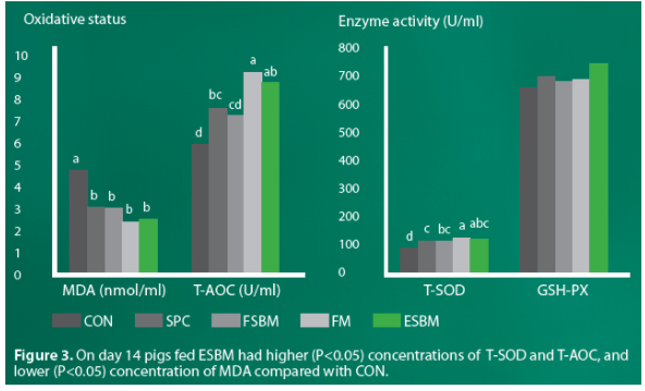



Improve performance by improving the oxidative status
During weaning, piglets are inevitably developing oxidative stress conditionsDuring weaning, piglets are inevitably developing oxidative stress conditions as environmental surroundings, diets and litter sizes are changing, while the young piglet is undergoing a rapid physiological transformation. This condition can be further enhanced by low grade feed ingredients in weaning diets; making piglets more prone to health issues and consequently reduced performance.
Feed ingredients in weaning diets can trigger oxidative stress conditions due to anti-nutritional factors (ANFs) i.e. soy antigens. Antigens cause inflammation, which generates free radicals locally in the gut. To battle the release of free radicals and avoid oxidative stress conditions, the natural radical defense system in piglets is activated. In turn, the oxidative stress condition further contribute to inflammation by upregulating the production of pro-inflammatory cytokines. This is known as the viscous circle of inflammation and when activated over a prolonged time period the local inflammation turns systemic and the piglet moves from a sub-clinical to a clinical condition.
How to avoid oxidative stress?
Two approaches are normally taken to avoid oxidative stress condition, prevention or treatment. Supplementing antioxidants such as vitamin E directly to the feed is one treatment approach as the antioxidants battle the free radicals and reduce oxidative stress. Another way is to prevent or diminish oxidative stress from happening by leaving out feed components that induces inflammation and oxidative stress, such as the soy antigens glycinin and β-conglycinin. This will also have a sparing effect on the natural antioxidant capacity of piglets and reduce the need for additional antioxidants in the feed.
Improved oxidative status with HP 300
A piglet study at the China Agricultural University in Beijing was conducted to identify the oxidative stress load in weaning piglets exposed to different protein feed ingredients i.e. different level of antigens (Figure 1). Weaned piglets were fed a starter diet containing either regular soybean meal (SBM), soy protein concentrate (SPC), fermented soybean meal (FSBM), fishmeal (FM) or HP 300 (enzymatically treated soy bean meal - ESBM) for 14 days post weaning. Active antioxidant enzyme systems and total antioxidant capacity indicate antioxidant capacity in the body. The malonyldialdehyde (MDA) is a biomarker of oxidative damage to cell tissue by free radicals present in the body. Together, these measurements represent how much oxidative stress the piglets need to battle when fed diets of different antigen content. High enzyme activity and low MDA levels in piglets mean little need for battling oxidative stress. Piglets respond to the improved oxidative status by higher daily gain as reflected in Figure 1.


How can performance be improved
Piglets are inevitably exposed to oxidative stress at weaning due to the many changes in the close environment while going through a physiological transformation and rapid growth. To giver piglets a better start and reduce the amount of stressors during this critical time period close attention should be given to feed ingredients used in weaning diets. This research data shows that selecting the right protein ingredients i.e. HP 300 immediately converts into lower oxidative stress and better growth performance in weaning piglets.










